Apps like Calorie AI are generating tens of millions of dollars a year, and the surprising fact is that their core functionality often boils down to a single API call to OpenAI. Imagine creating your own calorie and nutrition analysis app without writing a single line of code. This article walks you through building a fully functional Calorie AI clone by combining the no-code frontend builder Lovable with the powerful automation platform n8n as the backend, all powered by OpenAI’s Vision API.
If you want to build AI-powered automation tools or apps like this, consider joining our free AI Automation Community. There you can access all of our templates, tutorials, and support to accelerate your AI projects.
Building an AI-Powered Calorie and Nutrition App Without Coding
The goal is to create an app where users upload a photo of their meal, and the app instantly returns detailed calorie information and nutritional breakdowns. The entire process is powered by AI and no coding is required. We’ll use Lovable to generate the frontend interface through simple prompting, and n8n to automate backend workflows including image analysis and data extraction.
Here’s the high-level overview of how the system works:
- A user uploads an image of their meal via the Lovable app frontend.
- The image is sent via an HTTP request to an n8n webhook endpoint.
- n8n calls OpenAI’s Vision API to analyze the image and generate a descriptive nutritional analysis.
- A second AI prompt extracts structured data like calories, macros, and confidence scores from the text response.
- n8n returns this structured JSON data as the API response.
- Lovable displays the nutrition information back to the user.
This no-code approach allows rapid development of a sophisticated AI app that can compete with existing products making millions in revenue.
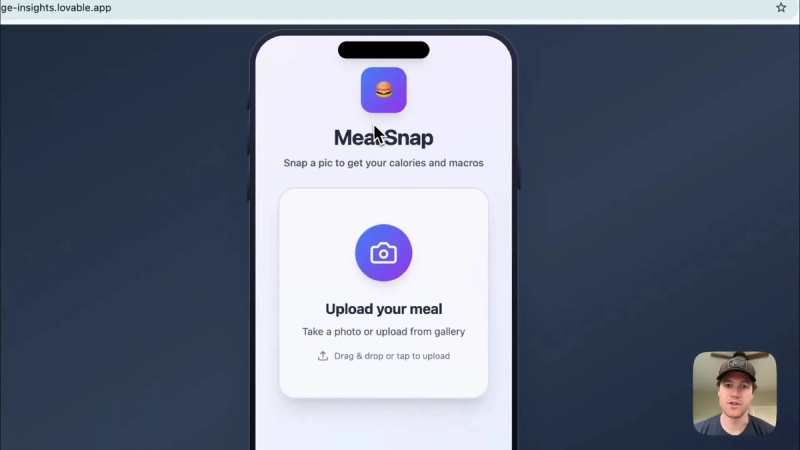
Creating a Simple Frontend in Lovable
To get started, we build a basic web app in Lovable with just three components:
- A text input field for entering the backend API URL.
- A file upload component to upload a photo of a meal.
- A submit button to send the image to the backend and display the response.
Using an AI prompt, Lovable generates the entire frontend interface for us. The prompt specifies that the app should validate the URL input, handle file uploads, make HTTP POST requests to the URL, and display the JSON response or any error messages clearly.
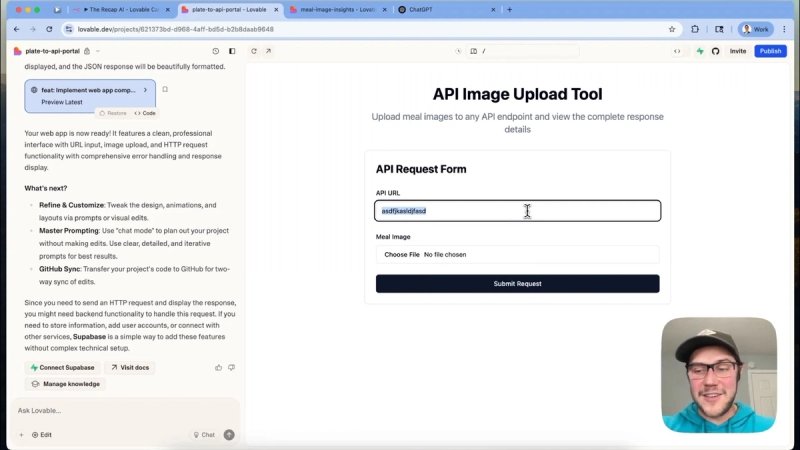
After the initial prompt, Lovable produces a clean, modern interface that matches the requirements without any manual coding. This simple app serves as the foundation for building more complex features later.
Building the Backend API with n8n
Next, we configure an n8n workflow to serve as the backend API endpoint. This workflow is triggered by an incoming webhook that accepts HTTP POST requests containing the meal image.
Key configuration points include:
- Webhook Trigger: Set to accept POST requests for image uploads.
- Authentication: For production, ensure authentication is enabled to prevent unauthorized or spam requests.
- Respond to Webhook Node: This node sends the final response back to the Lovable app. Without this, the workflow would exit prematurely with a generic response.
Once the webhook receives the image, the workflow calls OpenAI’s Vision API using the “analyze image” operation. The latest model version is used to extract a detailed description of the meal in the image.
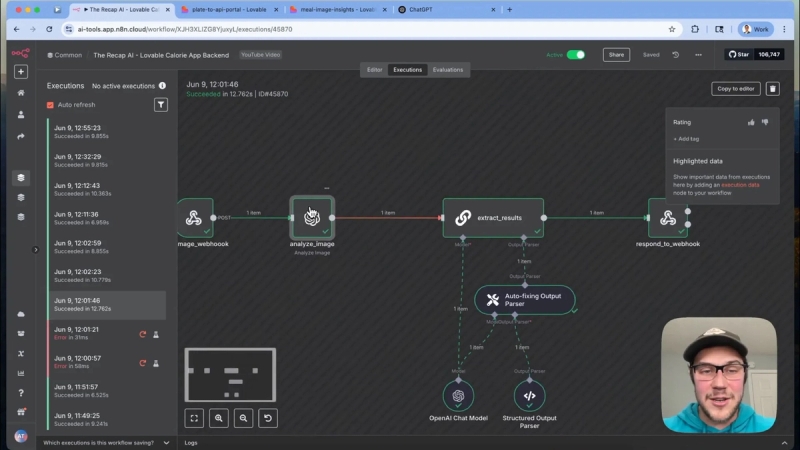
Following this, a second AI prompt processes the text description to extract structured nutritional data. This includes:
- Meal name
- Calories
- Grams of protein, carbohydrates, and fats
- Confidence score (how sure the AI is about its analysis)
- Health score (rated 0 to 10, indicating the meal's nutritional quality)
To make the system more robust, two output parsers are used:
- Structured Output Parser: Defines the expected JSON format.
- Autofixing Output Parser: Automatically corrects formatting errors in the AI’s response to ensure valid JSON output.
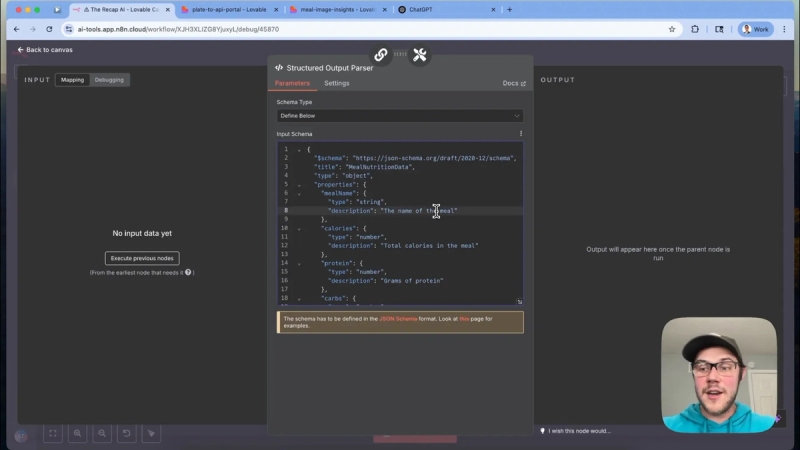
Finally, the workflow returns the structured JSON response to the Lovable frontend, completing the data loop.
Connecting Lovable Frontend to n8n Backend
With both frontend and backend ready, the next step is wiring them together. In Lovable, paste the n8n webhook URL into the text input field and upload a meal image. When the submit button is clicked, the app sends the image to the n8n backend.
n8n processes the image and returns the nutritional data, which Lovable then displays. This round-trip communication proves the system works end-to-end without any coding.

It’s important to note that when initially building this, Lovable might return mocked data if the API endpoint is not real or not correctly wired. Troubleshooting involves verifying that n8n executions are running and returning correct data, then ensuring Lovable uses the real API response instead of mock data.
Refining the Lovable App with Iterative Prompts
After the basic functionality is working, you can improve the Lovable app’s design and user experience by iteratively prompting the AI to make style adjustments. For example:
- Applying mobile app styling based on screenshots or design references.
- Wrapping the app interface in an iPhone mockup container for a polished demo look.
- Adjusting spacing, button styles, and layout for better usability.
Lovable also offers a unique feature to restrict edits to specific UI components using a “target sign.” This allows precise styling without undoing other changes.
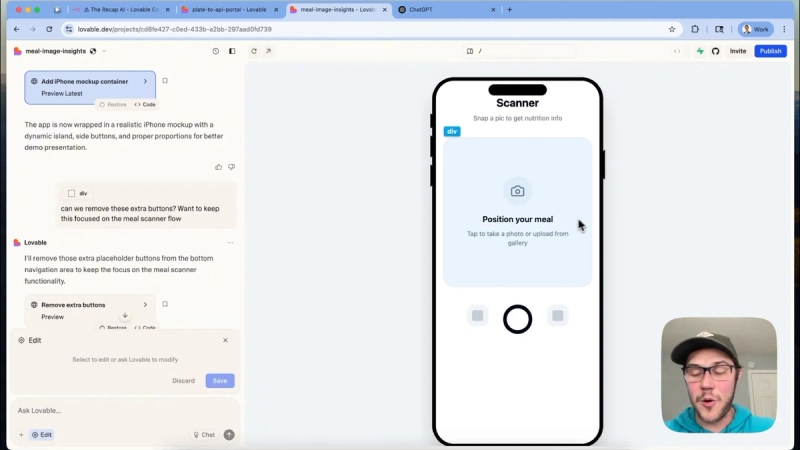
By combining these prompts and targeted edits, you can create a professional-looking app interface that feels like a native mobile app.
Extending the App for Production Use
The simple app demonstrated here processes one meal image at a time and displays results immediately. To build a production-ready application, you’ll want to add features such as:
- Saving scanned meal results to a database for user history.
- Allowing users to view a history of all scanned meals when they log in.
- Adding authentication and user management.
- Implementing additional endpoints in n8n for data storage and retrieval.
In n8n, this means creating additional webhook triggers to handle different API endpoints. For example:
- A webhook to save scan results to a database like Supabase.
- A webhook to retrieve past meal scans from the database.
Each webhook would use the “respond to webhook” node to send back appropriate JSON responses to the frontend.
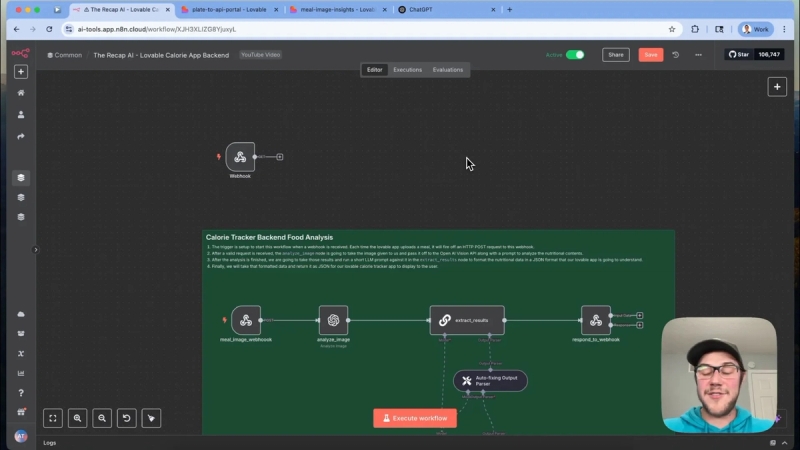
This modular approach allows you to build complex applications by composing simple, reusable workflows in n8n, all without writing code.
Key Considerations for Building AI-Powered Apps
- Authentication: Never leave your API endpoints open in production. Use tokens or passwords to secure access and prevent abuse.
- Timeouts: AI-powered image analysis can take time. Set appropriate request timeouts (e.g., 30 seconds) to avoid premature errors.
- Error Handling: Build in validation and error messages on the frontend to inform users of issues like missing URLs or failed uploads.
- Output Parsing: Use structured and autofixing parsers to ensure AI responses are clean and usable.
- Iterative Design: Use AI prompting to refine UI/UX repeatedly until the app meets your standards.
Conclusion: Build Your Own AI Nutrition App Today
By combining Lovable and n8n with OpenAI’s Vision API, you can build a fully functional calorie and nutrition analysis app without writing code. This approach unlocks the ability to create powerful AI-driven applications quickly and affordably.
Join our AI Automation Mastery community to access free n8n templates, step-by-step tutorials, and expert support from our community of builders.





